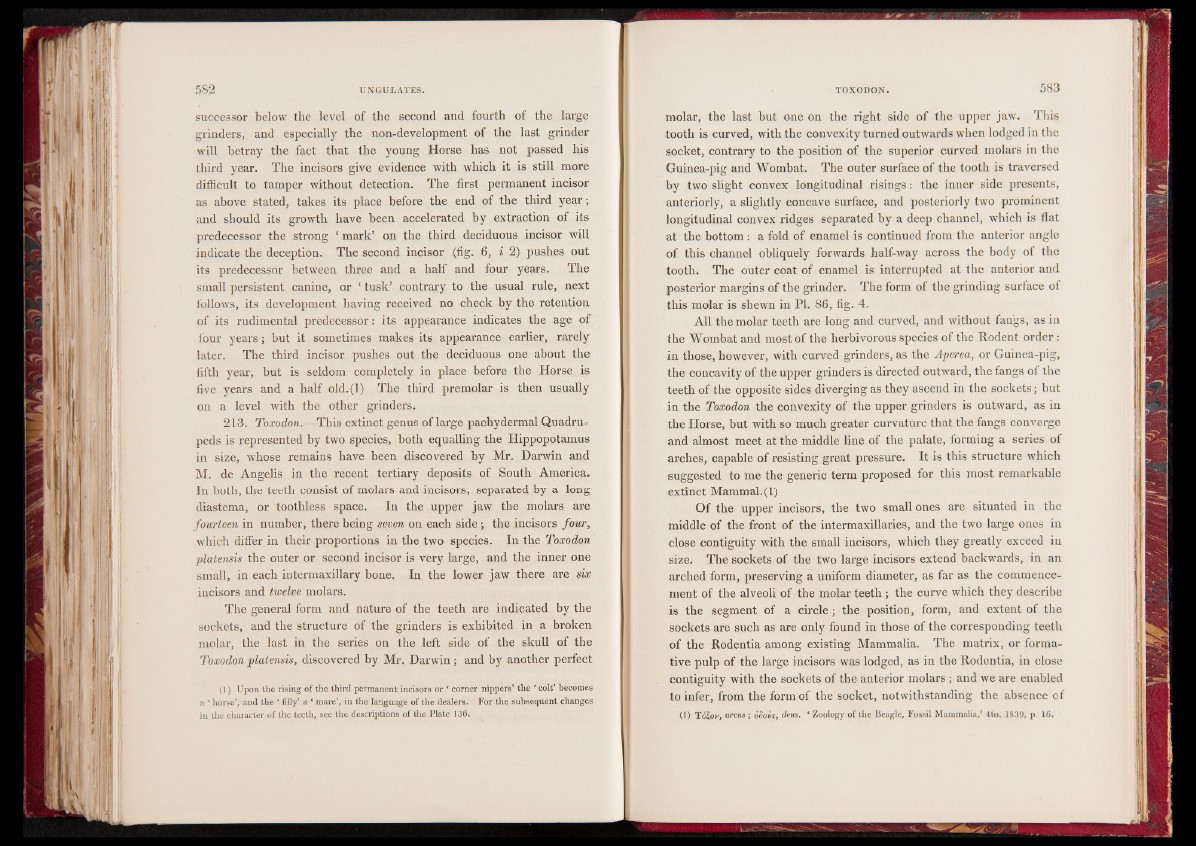
successor below the level of the second and fourth of the large
grinders, and especially the non-development of the last grinder
will betray the fact that the young Horse has not passed his
third year. The incisors give evidence with which it is still more
difficult to tamper without detection. The first permanent incisor
as above stated, takes its place before the end of the third year;
and should its growth have been accelerated by extraction of its
predecessor the strong ‘ mark’ on the third deciduous incisor will
indicate the deception. The second incisor (fig. 6, i 2) pushes out
its predecessor between three and a half and four years. The
small persistent canine, or ‘ tusk’ contrary to the usual rule, next
follows, its development having received no check by the retention
of its rudimental predecessor: its appearance indicates the age of
four years; but it sometimes makes its appearance earlier, rarely
later. The third incisor pushes out the deciduous one about the
fifth year, but is seldom completely in place before the Horse is
five years and a half old.(l) The third premolar is then usually
on a level with the other grinders.
213. Toxodon.—This extinct genus of large pachydermal Quadrupeds
is represented by two species, both equalling the Hippopotamus
in size, whose remains have been discovered by Mr. Darwin and
M. de Angelis in the recent tertiary deposits of South America.
In both, the teeth consist of molars and incisors, separated by a long
diastema, or toothless space. In the upper jaw the molars are
fourteen in number, there being seven on each side ; the incisors four,
which differ in their proportions in the two species. In the Toxodon
platensis the outer or second incisor is very large, and the inner one
small, in each intermaxillary bone. In the lower jaw there are six
incisors and twelve molars.
The general form and nature of the teeth are indicated by the
sockets, and the structure of the grinders is exhibited in a broken
molar, the last in the series on the left side of the skull of the
Toxodon platensis, discovered by Mr. Darwin; and by another perfect 1
(1) Upon the rising of the third permanent incisors or ‘ corner nippers’ the ‘ colt’ becomes
a | horse’, and the f filly’ a ‘ mare’, in the language of the dealers. For the subsequent changes
in the character of the teeth, see the descriptions of the Plate 136.
molar, the last but one on the right side of the upper jaw. This
tooth is curved, with the convexity turned outwards when lodged in the
socket, contrary to the position of the superior curved molars in the
Guinea-pig and Wombat. The outer surface of the tooth is traversed
by two slight convex longitudinal risings: the inner side presents,
anteriorly, a slightly concave surface, and posteriorly two prominent
longitudinal convex ridges separated by a deep channel, which is flat
at the bottom: a fold of enamel is continued from the anterior angle
of this channel obliquely forwards half-way across the body of the
tooth. The outer coat of enamel is interrupted at the anterior and
posterior margins of the grinder. The form of the grinding surface of
this molar is shewn in PI. 86, fig. 4.
All the molar teeth are long and curved, and without fangs, as in
the Wombat and most of the herbivorous species of the Rodent order:
in those, however, with curved grinders, as the Aperea, or Guinea-pig,
the concavity of the upper grinders is directed outward, the fangs of the
teeth of the opposite sides diverging as they ascend in the sockets; but
in the Toxodon the convexity of the upper grinders is outward, as in
the Horse, but with so much greater curvature that the fangs converge
and almost meet at the middle line of the palate, forming a series of
arches, capable of resisting great pressure. It is this structure which
suggested to me the generic term proposed for this most remarkable
extinct Mammal.(1)
Of the upper incisors, the two small ones are situated in the
middle of the front of the intermaxillaries, and the two large ones in
close contiguity with the small incisors, which they greatly exceed in
size. The sockets of the two large incisors extend backwards, in an
arched form, preserving a uniform diameter, as far as the commencement
of the alveoli of the molar teeth ; the curve which they describe
is the segment of a circle; the position, form, and extent of the
sockets are such as are only found in those of the corresponding teeth
of the Rodentia among existing Mammalia. The matrix, or formative
pulp of the large incisors was lodged, as in the Rodentia, in close
contiguity with the sockets of the anterior molars ; and we are enabled
to infer, from the form of the socket, notwithstanding the absence of
ifin Toi;ov, arms ; otiovs, dens. ‘ Zoology of the Beagle, Fossil Mammalia,’ 4to. 1839, p 16,